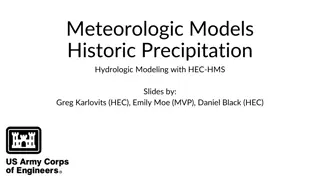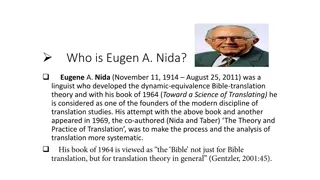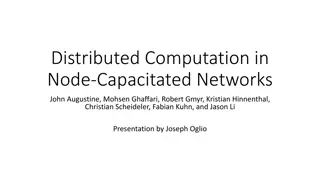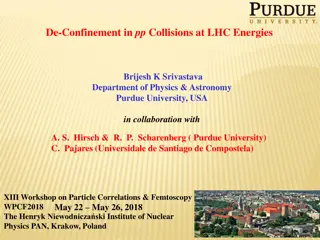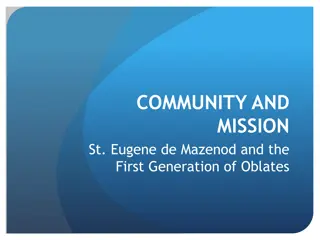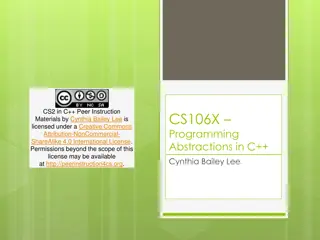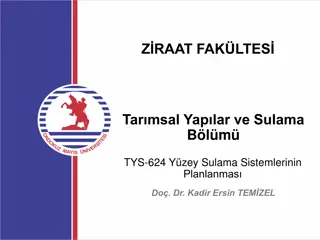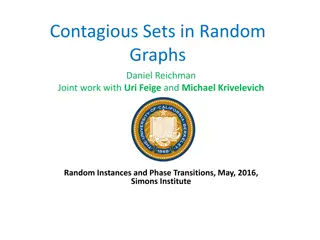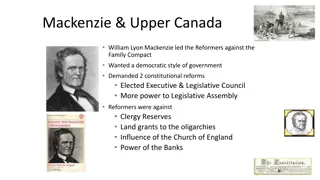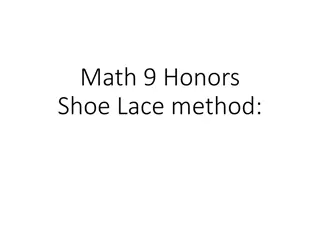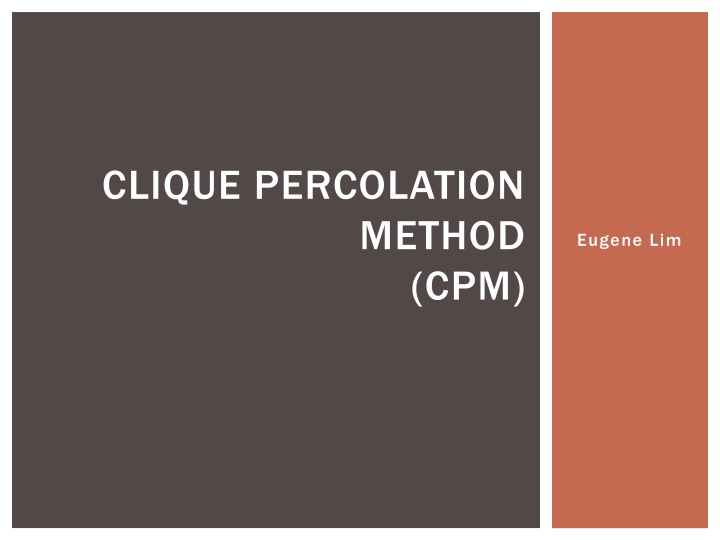
Clique Percolation Method (CPM) in Network Analysis
Explore the Clique Percolation Method (CPM) developed by Eugene Lim for detecting overlapping communities in networks. Learn about cliques, k-cliques, and adjacent k-cliques in the context of CPM, enabling a deeper understanding of community structures within a network.
Download Presentation

Please find below an Image/Link to download the presentation.
The content on the website is provided AS IS for your information and personal use only. It may not be sold, licensed, or shared on other websites without obtaining consent from the author. If you encounter any issues during the download, it is possible that the publisher has removed the file from their server.
You are allowed to download the files provided on this website for personal or commercial use, subject to the condition that they are used lawfully. All files are the property of their respective owners.
The content on the website is provided AS IS for your information and personal use only. It may not be sold, licensed, or shared on other websites without obtaining consent from the author.
E N D
Presentation Transcript
CLIQUE PERCOLATION METHOD (CPM) Eugene Lim
CONTENTS What is CPM? Algorithm Analysis Conclusion
WHAT IS CPM? Method to find overlapping overlapping communities Based on concept: internal edges of community likely to form cliques Intercommunity edges unlikely to form cliques
CLIQUE Clique: Complete graph k-clique: Complete graph with k vertices
CLIQUE Clique: Complete graph k-clique: Complete graph with k vertices 3-clique
CLIQUE Clique: Complete graph k-clique: Complete graph with k vertices 4-clique
CLIQUE Clique: Complete graph k-clique: Complete graph with k vertices 5-clique
K-CLIQUE COMMUNITIES Adjacent k Adjacent k- -cliques cliques Two k-cliques are adjacent when they share k k- -1 1 nodes
K-CLIQUE COMMUNITIES Adjacent k Adjacent k- -cliques cliques Two k-cliques are adjacent when they share k k- -1 1 nodes k = 3
K-CLIQUE COMMUNITIES Adjacent k Adjacent k- -cliques cliques Two k-cliques are adjacent when they share k k- -1 1 nodes k = 3 Clique 1
K-CLIQUE COMMUNITIES Adjacent k Adjacent k- -cliques cliques Two k-cliques are adjacent when they share k k- -1 1 nodes Clique 2 k = 3
K-CLIQUE COMMUNITIES Adjacent k Adjacent k- -cliques cliques Two k-cliques are adjacent when they share k k- -1 1 nodes Clique 3 k = 3
K-CLIQUE COMMUNITIES Adjacent k Adjacent k- -cliques cliques Two k-cliques are adjacent when they share k k- -1 1 nodes Clique 2 k = 3 Clique 1
K-CLIQUE COMMUNITIES Adjacent k Adjacent k- -cliques cliques Two k-cliques are adjacent when they share k k- -1 1 nodes Clique 2 Clique 3 k = 3
K-CLIQUE COMMUNITIES k k- -clique community clique community Union of all k-cliques that can be reached from each other through a series of adjacent k-cliques
K-CLIQUE COMMUNITIES k k- -clique community clique community Union of all k-cliques that can be reached from each other through a series of adjacent k-cliques Clique 2 k = 3 Clique 1
K-CLIQUE COMMUNITIES k k- -clique community clique community Union of all k-cliques that can be reached from each other through a series of adjacent k-cliques Community 1 k = 3
K-CLIQUE COMMUNITIES k k- -clique community clique community Union of all k-cliques that can be reached from each other through a series of adjacent k-cliques Community 1 Clique 3 k = 3
K-CLIQUE COMMUNITIES k k- -clique community clique community Union of all k-cliques that can be reached from each other through a series of adjacent k-cliques Community 1 Community 2 k = 3
ALGORITHM Locate maximal cliques Convert from cliques to k-clique communities
LOCATE MAXIMAL CLIQUES Largest possible clique size can be determined from degrees of vertices Starting from this size, find all cliques, then reduce size by 1 and repeat
LOCATE MAXIMAL CLIQUES Finding all cliques: brute-force 1. Set A initially contains vertex v, Set B contains neighbours of v 2. Transfer one vertex w from B to A 3. Remove vertices that are not neighbours of w from B 4. Repeat until A reaches desired size 5. If fail, step back and try other possibilities
ALGORITHM Locate maximal cliques Convert from cliques to k-clique communities
CLIQUES TO K-CLIQUE COMMUNITIES Clique 1: 5-clique
CLIQUES TO K-CLIQUE COMMUNITIES Clique 2: 4-clique
CLIQUES TO K-CLIQUE COMMUNITIES Clique 3: 4-clique
CLIQUES TO K-CLIQUE COMMUNITIES Clique 4: 4-clique
CLIQUES TO K-CLIQUE COMMUNITIES Clique 5: 3-clique
CLIQUES TO K-CLIQUE COMMUNITIES Clique 6: 3-clique
CLIQUES TO K-CLIQUE COMMUNITIES 1 1 2 2 3 3 4 4 5 5 6 6 1 1 5 2 2 4 3 3 4 4 4 4 5 5 3 6 6 3
CLIQUES TO K-CLIQUE COMMUNITIES 1 1 2 2 3 3 4 4 5 5 6 6 1 1 5 3 1 3 1 2 2 2 3 4 1 1 1 2 3 3 1 1 4 2 1 2 4 4 3 1 2 4 0 1 5 5 1 1 1 0 3 2 6 6 2 2 2 1 2 3
CLIQUES TO K-CLIQUE COMMUNITIES Clique 1: 5-clique
CLIQUES TO K-CLIQUE COMMUNITIES Clique 2: 4-clique
CLIQUES TO K-CLIQUE COMMUNITIES 1 1 2 2 3 3 4 4 5 5 6 6 1 1 5 3 1 3 1 2 2 2 3 4 1 1 1 2 3 3 1 1 4 2 1 2 4 4 3 1 2 4 0 1 5 5 1 1 1 0 3 2 6 6 2 2 2 1 2 3
CLIQUES TO K-CLIQUE COMMUNITIES k=4 1 1 2 2 3 3 4 4 5 5 6 6 1 1 5 3 1 3 1 2 2 2 3 4 1 1 1 2 3 3 1 1 4 2 1 2 4 4 3 1 2 4 0 1 5 5 1 1 1 0 3 2 6 6 2 2 2 1 2 3
CLIQUES TO K-CLIQUE COMMUNITIES k=4 1 1 2 2 3 3 4 4 5 5 6 6 1 1 5 3 1 3 1 2 2 2 3 4 1 1 1 2 3 3 1 1 4 2 1 2 4 4 3 1 2 4 0 1 5 5 1 1 1 0 3 2 6 6 2 2 2 1 2 3
CLIQUES TO K-CLIQUE COMMUNITIES k=4 1 1 2 2 3 3 4 4 5 5 6 6 1 1 5 3 1 3 1 2 2 2 3 4 1 1 1 2 3 3 1 1 4 2 1 2 4 4 3 1 2 4 0 1 5 5 1 1 1 0 0 2 6 6 2 2 2 1 2 0 Delete if less than k
CLIQUES TO K-CLIQUE COMMUNITIES k=4 1 1 2 2 3 3 4 4 5 5 6 6 1 1 5 3 1 3 1 2 2 2 3 4 1 1 1 2 3 3 1 1 4 2 1 2 4 4 3 1 2 4 0 1 5 5 1 1 1 0 0 2 6 6 2 2 2 1 2 0
CLIQUES TO K-CLIQUE COMMUNITIES k=4 1 1 2 2 3 3 4 4 5 5 6 6 1 1 5 3 1 3 1 2 2 2 3 4 1 1 1 2 3 3 1 1 4 2 1 2 4 4 3 1 2 4 0 1 5 5 1 1 1 0 0 2 6 6 2 2 2 1 2 0
CLIQUES TO K-CLIQUE COMMUNITIES k=4 1 1 2 2 3 3 4 4 5 5 6 6 1 1 5 3 0 3 0 0 2 2 3 4 0 0 0 0 3 3 0 0 4 0 0 0 4 4 3 0 0 4 0 0 5 5 0 0 0 0 0 0 6 6 0 0 0 0 0 0 Delete if less than k-1
CLIQUES TO K-CLIQUE COMMUNITIES k=4 1 1 2 2 3 3 4 4 5 5 6 6 1 1 5 3 0 3 0 0 2 2 3 4 0 0 0 0 3 3 0 0 4 0 0 0 4 4 3 0 0 4 0 0 5 5 0 0 0 0 0 0 6 6 0 0 0 0 0 0
CLIQUES TO K-CLIQUE COMMUNITIES k=4 1 1 2 2 3 3 4 4 5 5 6 6 1 1 1 1 0 1 0 0 2 2 1 1 0 0 0 0 3 3 0 0 1 0 0 0 4 4 1 0 0 1 0 0 5 5 0 0 0 0 0 0 6 6 0 0 0 0 0 0 Change all non-zeros to 1
CLIQUES TO K-CLIQUE COMMUNITIES k=4 1 1 2 2 3 3 4 4 5 5 6 6 1 1 1 1 0 1 0 0 2 2 1 1 0 0 0 0 3 3 0 0 1 0 0 0 4 4 1 0 0 1 0 0 5 5 0 0 0 0 0 0 6 6 0 0 0 0 0 0 Clique-clique overlap matrix
CLIQUES TO K-CLIQUE COMMUNITIES k=4 Community 1

